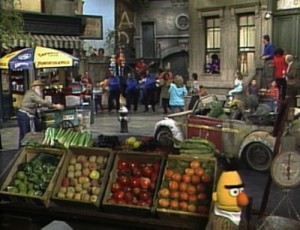Readers: Sesame Street Was a Positive Influence on Their Perception of Urban Neighborhoods
When Sesame Street debuted in November 1969 I was and wasn’t the target audience. Just shy of turning 3, I was the ideal age for the new educational show, but I was a kid in a new middle-class suburban subdivision in the sprawling city of Oklahoma City.

Think about the decade of the 1960s, leaders assassinated (JFK, MLK), race riots in cities, etc. The show was targeted at poor inner-city kids, helping them learn and to feel good about their own neighborhoods — which didn’t look like Mr Roger’s Neighborhood (1968) or another show from 1969, The Brady Bunch. I’m not the only person who’s written about growing up with Sesame Street:
Sesame Street was my first experience of a city. I had no idea where it was set when I was a kid, or even that it was in a city at all. I tended to imagine all settings as more or less equivalent to the small Midwestern city where I grew up. I was shocked as an adult to learn that Harriet the Spy, to take one example, was an Upper West Sider. As far as I was concerned, she lived down the block. I didn’t realize how centralized American culture is, how little of America Sesame Street depicts. I didn’t realize my life was considered provincial.
Sesame Street is supposed to represent a Manhattan street, which should be obvious to anyone who’s watched the program — though it wasn’t to me until I asked the show’s art director, Victor Di Napoli. I was thinking that it might be located in, oh, I don’t know, Brooklyn or Philadelphia (it’s actually filmed on a soundstage in Astoria, Queens). The folks at Sesame Street actually disagree over which specific Manhattan neighborhood the show depicts. Di Napoli, a longtime Sesame Street staffer, says it’s always been based on the Upper West Side, though Joan Ganz Cooney, Sesame Street’s founder, said during a 1994 talk at the Museum of Television and Radio in New York that she’d wanted to call the show 123 Avenue B — in the late ’60s, this now prosperous part of the East Village was called Alphabet City, and was considered part of the Lower East Side.
Whether or not I understood Sesame Street’s setting, it stuck in my head as a model for how people should live: close to one another, in a place where neighbors knew, liked, and watched out for each other, where chance encounters were common and meaningful. And I’ve sought that out repeatedly in my adult life. (How to Get to Sesame Street)
And based on the unscientific poll results many of you were also positively influenced:
Q: How did Sesame Street influence your childhood perceptions of urban neighborhoods?
- Positively 69 [37.91%]
- Very positively 66 [36.26%]
- Neutral 21 [11.54%]
- Unsure/No Answer/Not Applicable 21 [11.54%]
- Negatively 4 [2.2%]
- Very negatively 1 [0.55%]
Nearly 75% indicated Sesame Street positively or very positively influenced their perceptions of urban neighborhoods. The comments on the original post are interesting, some doubting the influence of the show and others saying they too wanted to experience such a way of living.
As a kid growing up in a 600-person country town, I don’t think I once equated Sesame Street with “urban” or “city.” No doubt that was its setting, but even as a kid, it existed as a back drop to what was, in essence, an ongoing stage play.
Sesame Street didn’t try to extol the virtues of the urban environment or even really reference it at all (again, to my untrained kiddy eyes). A great show, no doubt, and I’ll gladly plop my own future kids in front of the TV to learn and laugh — but there’s no real connection between the “city” of the Street and the streets of a City, if that makes since.
“Sunny day, sweepin’ the…clouds away…” 🙂